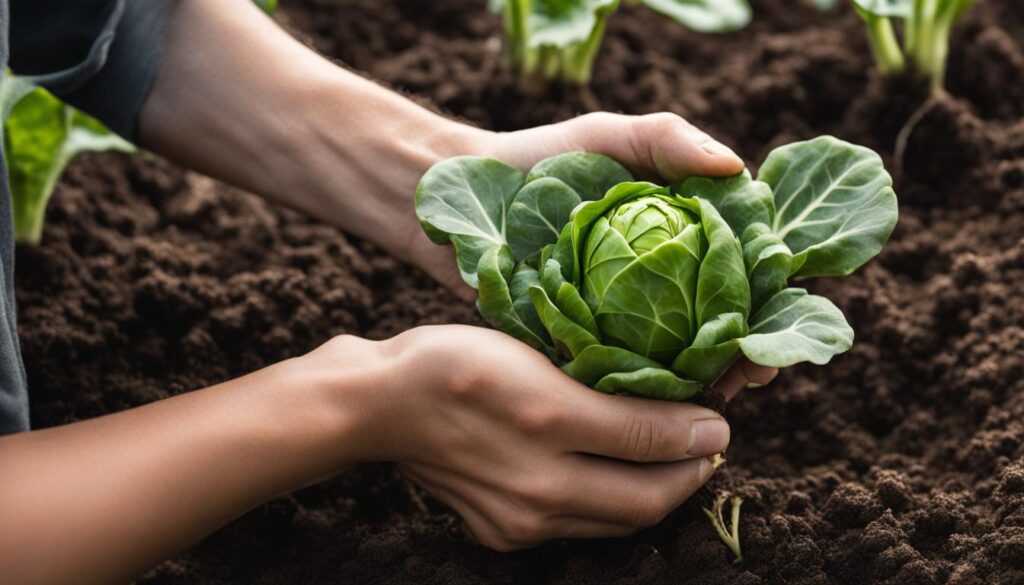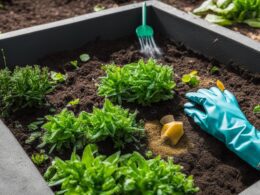In South Carolina, planting brussels sprouts can be a rewarding and enjoyable activity, yielding nutritious and flavorful winter harvests. With the state’s unique climate, timing is crucial to ensure growing brussels sprouts successfully. So, what are the best planting dates for brussels sprouts in the region? Read on to learn how to effectively integrate these tasty vegetables into your South Carolina gardening plans.
Key Takeaways
- Brussels sprouts prefer cooler temperatures between 65 and 80°F for optimal growth in South Carolina.
- For Upstate gardeners, plant transplants should be set out between August 15 and September 15.
- Coastal Plain gardeners should transplant brussels sprouts between September 15 and October 15.
- Starting seeds indoors in early July is essential for both Upstate and Coastal Plain gardeners.
- Ensure proper soil preparation, spacing, and watering techniques for successful transplanting and growth.
- Brussels sprouts are hardy vegetables that can withstand frost and even taste sweeter after a frosty exposure.
- Stay vigilant against pests and practice effective pest control techniques to protect your crop.
Understanding Brussels Sprouts: A Hardy Vegetable for Your Garden
Brussels sprouts, known for their resilience, are part of the brassica family and considered a hardy vegetable. Thriving in cooler climates, they share similarities with other common Southern crops, such as collards and broccoli. Rich in nutritional value, including vitamin K and vitamin C, brussels sprouts add significant benefits to your garden.
The unique growth habit of brussels sprouts consists of developing edible axillary buds along their stalks, which resemble mini cabbages. As cold-season crops, they can withstand frost, allowing them to be harvested late into the year and even through winter months in some regions. Despite being slow-growing, the patience needed for successful brussels sprouts cultivation pays off with a nutrient-dense addition to your table.
- Hardy vegetables: Brussels sprouts’ resilience enables them to withstand frost and thrive in cooler climates.
- Brassicas: Closely related to collards and broccoli, with similar climate preferences and nutritional benefits.
- Cold-season crops: Brussels sprouts can be harvested late in the year and can survive exposure to frost, making them unique additions to your garden.
| Nutrient | Amount per 100g | Percentage of Daily Value |
|---|---|---|
| Vitamin K | 194.57 mcg | 162% |
| Vitamin C | 85 mg | 94% |
| Fiber | 3.8 g | 14% |
| Protein | 3.38 g | 7% |
| Calories | 43 kcal | 2% |
Focusing on long stalks during growth allows for higher yields of brussels sprouts. By maintaining optimal conditions and understanding their unique growth habits, these hardy vegetables can enrich your garden and be a valuable source of nutrition in your meals.
The Perfect Time to Plant Brussels Sprouts in South Carolina
When it comes to planting Brussels sprouts in South Carolina, timing is crucial for a successful harvest. The diverse growing seasons within the state allow for different planting dates depending on your location. In this section, we’ll discuss the optimal planting periods for both Upstate and Coastal Plain gardeners.
Take the following steps to successfully start your brussels sprouts seeds indoors:
- Gather your materials: You will need brussels sprouts seeds, seedling trays or small pots, sterilized seed-starting mix, a watering can or spray bottle, and a sunny window or grow light to provide ample light.
- Fill the trays or pots: Fill your seedling trays or pots with the seed-starting mix. Sow seeds approximately ¼ inch deep and cover lightly with more mix. Moisten the mix gently with a spray bottle or watering can to dampen the soil without soaking it.
- Provide light and warmth: Place your seeded trays or pots in a sunny window or under a grow light. Maintain a temperature between 65°F and 75°F to encourage germination, which should occur within 5 to 10 days.
- Water and monitor growth: Keep the soil consistently moist but not soaked by watering gently every few days. Observe your seedlings’ progress; healthy seedlings will reach a height of 2 to 4 inches in 5 to 7 weeks.
| Timeframe | Task |
|---|---|
| 5 to 7 weeks before transplant date | Start seeds indoors |
| 5 to 10 days post-sowing | Germination should occur |
| 5 to 7 weeks after germination | Seedlings should reach 2 to 4 inches in height |
Once your seedlings have reached the appropriate size and the outdoor planting window approaches, you can begin the transplant preparation process. By starting your brussels sprouts seeds indoors and following these steps, you will be well on your way to enjoying a bountiful harvest of delicious and nutritious brussels sprouts from your South Carolina garden.
Transplanting Brussels Sprouts: Steps for Success
Successfully transplanting brussels sprouts requires attention to soil preparation, proper spacing and depth, and effective watering and mulching techniques. Implementing these strategies will ensure optimal growth and yield for your garden.
Preparing Your Garden Soil
Proper soil preparation is essential for brussels sprouts growth. Select a site with full sun exposure, ideally away from tall trees or shrubs that compete for nutrients and light. To enhance plant health and yield, incorporate organic matter into the soil. This will help create a nutrient-rich environment to support the development of your transplants.
Garden Soil Preparation Steps:
- Choose a site with full sun exposure.
- Avoid areas near trees or shrubs that compete for nutrients and light.
- Incorporate organic matter into the soil to improve nutrient availability.
The Importance of Proper Spacing and Depth
When transplanting brussels sprouts, ensure adequate space for growth by placing each transplant 18 to 24 inches apart. This will prevent overcrowding and facilitate nutrient uptake. Equally important is planting at the correct depth—approximately the same depth as their original containers—allowing roots to establish and absorb nutrients effectively.
Transplanting Tips:
- Spacing: Place transplants 18 to 24 inches apart.
- Depth: Match the depth of the original container when transplanting.
Watering and Mulching Techniques
Throughout August and September, maintaining consistent soil moisture is especially crucial. Employ diligent watering practices, ensuring the soil remains damp to the touch. To aid in moisture retention, control soil temperature, and suppress weed growth, apply a layer of appropriate mulching materials around your transplants.
Watering and Mulching Recommendations:
- Monitor soil moisture to ensure it remains damp, not soggy.
- Utilize mulch to retain moisture, regulate temperature, and suppress weeds.
By adhering to these guidelines for transplanting brussels sprouts, garden soil preparation, and planting techniques, you can ensure a healthy and bountiful harvest.
Protecting Your Crop from Pests and Frost
Brussels sprouts, like other brassicas, may be susceptible to various pests and challenging weather conditions. However, with proper pest control in gardens and frost protection, brussels sprouts cultivation can thrive and yield a healthy, flavorful crop.
Common Pests that Threaten Brussels Sprouts
It is important to be vigilant in monitoring for pests common to brassicas, such as insects that also afflict crops like broccoli. Proactive measures can help maintain a healthy crop and reduce the risk of an infestation. Some common pests and effective management techniques include:
- Aphids: These small insects can cause significant damage by sucking sap from the leaves, leading to stunted growth and curling leaves. Use insecticidal soap or encourage beneficial insects like ladybugs that naturally feed on aphids.
- Cabbage loopers: These caterpillars can cause extensive damage by feeding on the leaves, creating holes and reducing yield. Employ organic pesticides or biological controls such as Bacillus thuringiensis (Bt) to manage their population.
- Cabbage root maggots: These larvae feed on the roots of brassicas, stunting growth and potentially causing the plant to wilt or die. Create a barrier on the soil surface with diatomaceous earth or fine sand to deter egg-laying flies.
Additionally, you can protect your plants by setting up protective coverings like row covers to keep pests away while still allowing sunlight and air circulation.
Maximizing Flavor: Letting Your Sprouts Experience Frost
Brussels sprouts benefit flavorfully from exposure to frost, as cooler temperatures promote the conversion of starches to sugars, giving the sprouts a sweeter taste. Following the planting schedule provided in previous sections ensures that sprouts mature during colder months when frost is more likely to occur. Thankfully, brussels sprouts are frost-tolerant plants that can withstand temperatures down to 20°F:
| Frost Temperature (°F) | Brussels Sprouts Effect |
|---|---|
| 32°F to 28°F | Some leaf damage possible but overall plant unaffected. |
| 28°F to 20°F | Sprouts become sweeter, plant remains hardy. |
| Below 20°F | Severe damage possible, may result in crop loss. |
Ensuring your brussels sprouts experience some frost not only enhances their flavor but also extends the harvesting window through winter, allowing you to enjoy fresh, homegrown veggies when many other crops are no longer in season.
Are the Planting Times for Brussels Sprouts and Collards in South Carolina Similar?
In South Carolina, the best time for planting collards is typically in the late summer or early fall, around August or September. Interestingly, the planting times for Brussels sprouts are quite similar, making it convenient for gardeners to plant both crops around the same time for a successful harvest.
Enjoying a Successful Brussels Sprouts Harvest in South Carolina
Growing brussels sprouts in South Carolina can be a rewarding experience, offering gardeners a nutritious and flavorful winter crop. By implementing the recommended planting schedule and proper care techniques, you can ensure a bountiful harvest that lasts from late fall to early spring. Providing resilience and adaptability to the Southern climate, brussels sprouts are an ideal vegetable for your garden.
Proper garden planning is essential to ensure a successful season of cultivating brussels sprouts. By following the outlined planting dates for upstate South Carolina gardeners (August 15 to September 15) and coastal plain gardeners (September 15 to October 15), you can optimize the growing period for this hardy vegetable. Starting seeds indoors five to seven weeks before the preferred garden planting date will help you stay on schedule and maximize yield.
Soil preparation, transplant spacing, and proactive pest control efforts are crucial in achieving a successful harvest. Adhering to transplant spacing recommendations of 18 to 24 inches apart, ensuring proper planting depth and consistent watering practices during the growing season will give your plants an optimal chance to thrive. Additionally, employing natural control techniques and protective coverings can keep detrimental pests at bay.
In conclusion, cultivating brussels sprouts in South Carolina requires careful planning, consistent care, and dedication to growing these hardy vegetables. By following the best practices shared in this article, you will be well on your way to a fruitful harvest that provides a nutritional and flavorsome crop to enjoy throughout the winter months.











